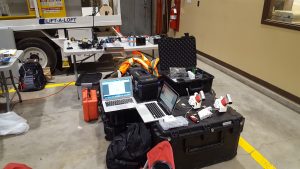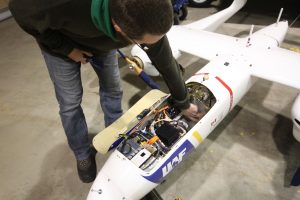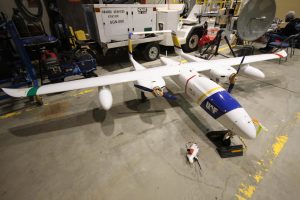Ok, so I might have forgotten to introduce myself in my first post… I’m Chris Cox, a research scientist in CIRES. I study the physical processes that exchange energy between the atmosphere and Arctic cryosphere – basically, I try to understand how the atmosphere controls melting and freezing of snow and ice. The SeaHunter/miniFlux contribution to the SODA experiment is aimed specifically at autumn freeze-up of the ocean north of Alaska. We endeavor to collect data that will be used to improve forecasts of the timing of the appearance of sea ice. Gijs and I regularly work together, but this is the first time we have collaborated on a UAS project. Gijs has a great deal of experience with UAS field campaigns, but this is my first. I’m excited to be involved. The mobility and flexibility of UAS technologies offer tremendous opportunities for targeted research.
Today, I did some testing of the miniFlux systems and I did take some photos. The SeaHunter team has completed assembly of the aircraft. Why does it need to be assembled, you say? Because it travels by truck. Weird, eh? Why not fly it where it needs to go? Well, Gijs has already explained some of the intricacies of flight planning and the strict rules the FAA imposes on unmanned systems, like SeaHunter. For this reason, SeaHunter travels in a trailer partially disassembled. In fact, SeaHunter, which is based out of Alabama, was driven here all the way from its last deployment in eastern Canada! That is quite the road trip the team had to take to get here! There are not many roads on the North Slope, but Kuparuk is in fact connected to Fairbanks, and by extension the rest of North America by Alaska state route 11, the Dalton Highway.
The reasons for my tests were so that I could check that miniFlux made it through its own journey to Kuparuk from Fairbanks where Cory worked with the SeaHunter team to finish its integration into the aircraft platform. I also wanted to go through the motions of pre-flight checks and start-up, as well as post-flight retrieval and processing of the data. In this way, I can be prepared to be as efficient as possible when it’s time to fly. We have two miniFlux systems, a primary and a back-up. We have not attached miniFlux to SeaHunter yet because the first SeaHunter flight will also be a test and this test is conducted without a payload. Then, we will follow-up with a second test that includes miniFlux before scheduling the first science flight over the ocean. For now, we are waiting for calmer winds.

The two miniFlux systems can be seen on box in the foreground – they are red, white and silver.

One of the pilots, Andrew, explains some of the features of the aircraft.

SeaHunter and miniFlux. When it is mounted later, miniFlux will attach to underside of the front of the fuselage using a mount within a modified nose cone.
